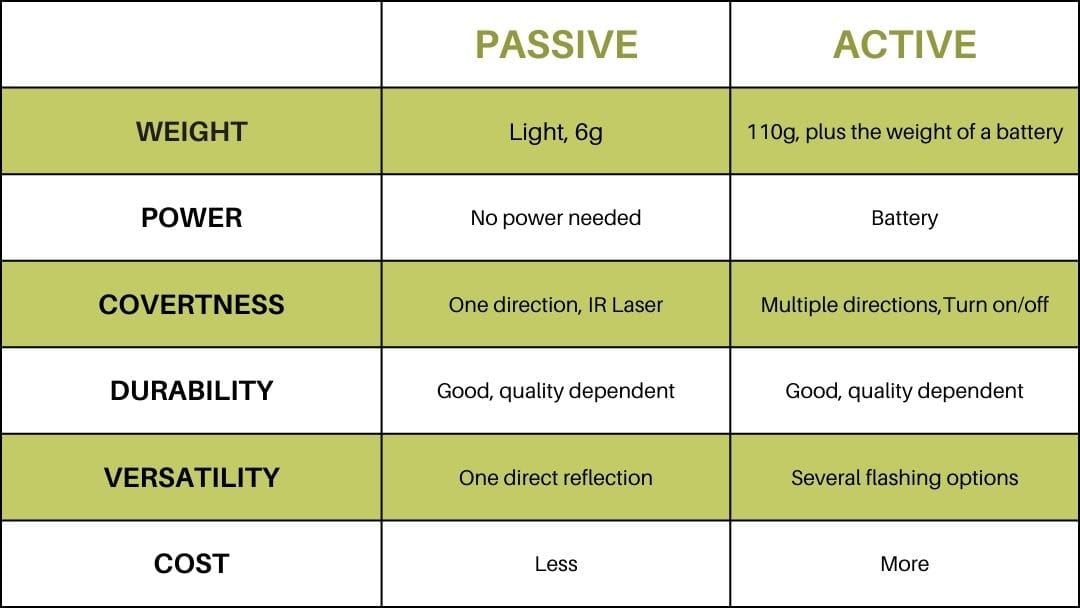While IR.Tools specializes in building primarily PASSIVE no-power infrared identification patches, we do not ignore the demand for ACTIVE-powered IR markers.
Both technologies are similiar because they safeguard you from friendly fire. However, there are several advantages and disadvantages to compare when choosing passive or active protection.
Below is a list of features to consider during this decision-making process. In some cases, you may find having both active and passive in the rucksack checks all the boxes and won’t ever leave you vulnerable.
Let’s review the following key differences.
Weight
Passive IR patches are lightweight. An IR.Tools laser-cut patch weighs less than 6g. A 6g patch on a uniform adds negligible weight on a uniform. Active beacons weigh more. One of the best active IR beacons available is the Adventure Lights VIP which comes in at 110g, more than 10X the weight of a laser-cut patch.
Power
The passive IR patches require no additional power source. It is a “no power” item therefore eliminates concerns for battery level. Active IR beacons do require a battery power source. Additionally, the battery weight needs to be considered.
Covertness
A passive IR patch will not glow until illuminated by an IR laser. Your position remains covert unless this illuminating beam, traveling in one direction hits your patch. When this happens you are only visible to the one with the beam.
An active IR will not emit any signal for any reason as long as it is not turned on. You will remain covert until you turn on the active beacon to draw attention to your position. Keep in mind, the beacon is seen in multiple directions which may or may not be beneficial.
Durability
While there are instances when an active beacon exhibits a longer life span than a passive IR patch, it is crucial to note this is dependent on the quality of your beacon or patch. For example, Adventure Lights VIP is significantly more robust than a Phoenix Jr. Beacon and an IR.Tools SandStorm Technology™ patch demonstrates superior durability when compared to a honeycomb-style patch.
Versatility
When it comes to versatility, the passive IR patch takes a back seat to the active beacon. An active ID beacon gives you access to strobes, codes, and multiple wavelengths. In contrast, passive ID relies on simple reflection. No secret codes with a passive IR patch. An IR patch may include a call sign or other custom designs but is permanent.
Cost
There is a significant cost difference. A passive IR patch is notably less. Typically an active beacon is 2-3 times greater.
Passive or Active?
You want to carefully assess all the pros and cons of a passive and active friend or foe marker. Consider how to incorporate each into your SOP (Standard Operating Procedure). Additionally, understand how to maximize the strengths of each to provide the ultimate protection for your operations.
In the end, you and your fellow warriors want to come home safe and hug your loved ones.

If you have any questions please be sure to contact us!
We look forward to working with you.
443.292.8885… ask for Tom!
tboyer@ir.tools

Since 2006, Tom has been the driving force behind IR.Tools, dedicated to delivering top-notch infrared solutions to the military, law enforcement, and sportsmen communities.
What began with a single infrared patch has blossomed into a comprehensive store featuring hundreds of IFF patches, vehicle IFF, an extensive suite of thermal training targets, and tools for drone pilots.
Beyond his innovative products, Tom is passionate about educating users on infrared technology and showcasing how advancements in IR can enhance their operations.
Tom holds an MS in Mechanical Engineering from the University of Maryland and an MBA from Regents University.

